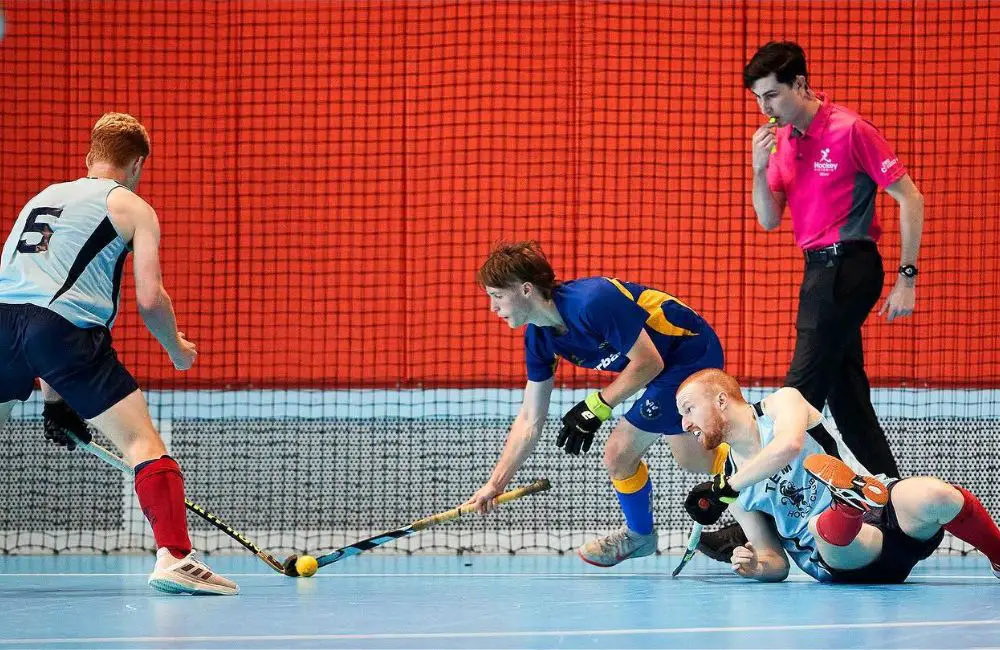Hockey and indoor hockey differ in terms of the playing surface and the size of the court. Outdoor field hockey is played on grass or synthetic turf, while indoor hockey can be played on a gymnasium floor, linoleum, or snap tiles.
Indoor hockey is characterized by a much smaller court size, which results in a faster-paced game. The limited space also requires players to focus on basic skills like passing and ball control. On the other hand, outdoor hockey allows for more open play and the use of larger, outdoor fields.
The differences in playing surface and court size impact the style and strategy of the game.
Difference Between Hockey And Indoor Hockey
Indoor hockey and outdoor hockey have significant differences in gameplay. While outdoor hockey is played on grass or synthetic fields, indoor hockey takes place on smaller courts with solid barriers instead of sidelines.
The smaller court size and faster pace in indoor hockey require players to focus on passing and quick movements. Additionally, indoor hockey sticks and balls are specifically designed for the unique requirements of the game.
Rules
When it comes to differences in gameplay between hockey and indoor hockey, one of the main aspects to consider is the rules. While both sports share similarities, there are key differences that set them apart. In outdoor hockey, the game is played on a large field with 11 players on each team.
There are specific rules governing the use of sticks and body contact, with players using their sticks to control and move the ball. Additionally, there are rules regarding fouls and penalties, such as obstruction and high sticks. Penalty corners and penalty strokes are also a part of the game, providing opportunities for teams to score.

Indoor hockey, on the other hand, is played on a smaller court with fewer players on each team, typically 6-7 players. The sidelines in outdoor hockey are replaced by solid barriers in indoor hockey, which means the ball remains in play, leading to a much faster-paced game.
The rules regarding body contact are also different in indoor hockey, as it employs a no-contact policy to maintain player safety.
Playing Area
The playing area is another aspect that sets hockey and indoor hockey apart. In outdoor hockey, the game is played on a large grass or synthetic field, typically measuring 91.4 meters in length and 55 meters in width. The field is divided into different zones, each serving a specific purpose within the game.
The large playing area allows for more freedom of movement and allows players to cover more ground. Indoor hockey, on the other hand, is played on a much smaller court, usually on a gymnasium floor, linoleum, or snap tiles.
The smaller playing area emphasizes quick decision-making and close-quarters gameplay. With limited space, players must adapt their strategies and use their basic skills, such as passing and control, to maneuver around opponents.
Shooting Circle
The shooting circle, also known as the D, is another area where hockey and indoor hockey differ in gameplay. In outdoor hockey, the shooting circle is a semicircular area around the goal, measuring 14.63 meters in diameter.
This area plays a crucial role in penalty corners and shooting opportunities, where attacking players aim to score goals. In indoor hockey, the shooting circle is smaller and more compact, measuring only 9 meters in diameter. Due to the size constraints of the indoor court, the shooting circle is reduced to accommodate the faster pace of the game.
This requires players to be more precise and efficient in their shooting techniques. In conclusion, the gameplay of hockey and indoor hockey differs in various aspects, including the rules, playing area, and shooting circle.
These differences contribute to the unique challenges and strategies required in each sport. Whether it’s the larger playing area and physicality of outdoor hockey or the speed and precision of indoor hockey, both sports offer exciting and competitive gameplay experiences.
Equipment And Gear
When it comes to playing hockey, whether it be on the field or indoors, having the right equipment and gear is essential. Understanding the differences in equipment between hockey and indoor hockey is important for players to excel in both versions of the game.
Sticks
In outdoor hockey, players use longer sticks compared to indoor hockey. Outdoor sticks are typically made of composite materials, offering the durability and strength needed for the rougher playing surface. These sticks are designed to handle the impact of hitting the ball on grass or synthetic fields.
On the other hand, indoor hockey sticks are shorter and lighter. Since the game is played in a smaller area, close ball control and quick passing are crucial. Indoor sticks are designed to facilitate these skills, allowing players to maneuver easily in tight spaces and make precise passes. These sticks often have a lower carbon content, making them lighter and more agile.
Gloves
Gloves in outdoor hockey are designed to protect from the elements and physical contact. They are typically heavier and offer additional padding to absorb impact. These gloves prioritize protection over flexibility.
In contrast, indoor hockey gloves focus more on flexibility and grip. Since the game is played on a smoother surface and with fewer physical battles, players require gloves that allow better hand movement and dexterity. Indoor hockey gloves are usually lighter and have better ventilation to ensure comfort during fast-paced indoor matches.
Balls
The differences between indoor and outdoor hockey balls are primarily in their design and durability. Indoor balls are lighter and smoother, allowing for quick and low-friction movement on indoor surfaces. They are designed to enhance the speed and agility required for indoor play.
Outdoor balls, on the other hand, are designed to withstand the variable conditions of outdoor fields. They are generally heavier and more durable, with a dimpled surface to cope with the rougher grass or synthetic field surfaces. This durability ensures that outdoor balls can endure the wear and tear of outdoor play.
Advantages And Disadvantages
Outdoor hockey is played on grass or a synthetic field, while indoor hockey can be played on a gymnasium floor, linoleum, or snap tiles, making it a faster-paced game. Indoor hockey is played on a smaller court, requiring players to use basic skills of passing and pulling.

When it comes to the differences between hockey and indoor hockey, there are several advantages and disadvantages to consider. Understanding these factors can help players choose which version of the sport suits them best.
Pace And Skill Development
The pace of the game is one of the stark contrasts between hockey and indoor hockey. Due to the confined playing area, indoor hockey is known for its fast-paced nature, with quick transitions and constant action.
This faster pace requires players to make split-second decisions, improving their agility, speed, and quick thinking. On the other hand, outdoor hockey offers a more spacious field, allowing players to cover larger distances and focus on endurance, stamina, and strategic positioning.
Furthermore, the skill development in both versions of the sport varies. Indoor hockey emphasizes close-control skills, as the smaller court size requires precise passing and ball control.
Players learn to maneuver around opponents in tight spaces, enhancing their ball-handling abilities. Outdoor hockey, on the other hand, allows for long passes and open play, allowing players to showcase their long-distance hitting, aerial balls, and strong dribbling skills.
Field Size And Team Size
The dimensions of the playing field and the number of players on each team are another notable difference between hockey and indoor hockey. In outdoor hockey, the field is larger, usually measuring 91.4 meters in length and 55 meters in width.
This expansive field provides players with more space to spread out, create plays, and exhibit their abilities in a wide range of positions. Additionally, outdoor hockey is typically played with 11 players on each team, allowing for a more diverse set of strategies and formations.
In contrast, indoor hockey is played on a smaller court, usually measuring 40 meters in length and 20 meters in width. The compact playing area necessitates players to be near one another, fostering intense, fast-paced encounters.
Furthermore, indoor hockey is played with only 6 players per team, including the goalkeeper. This reduced team size encourages players to be constantly involved in the game, improving their overall game awareness, decision-making, and communication skills.
Overall, the differences in field size and team size contribute to distinct playing styles and strategies in both hockey and indoor hockey. Whether players prefer the fast-paced, close-control nature of indoor hockey or the strategic and expansive nature of outdoor hockey depends on their skills, preferences, and personal playing style.
Final Thoughts
The difference between hockey and indoor hockey lies in the playing surface and the size of the court. While outdoor hockey is played on a grass or synthetic field, indoor hockey can be played on various surfaces such as a gymnasium floor or snap tiles.
The smaller court size in indoor hockey makes the game faster-paced, requiring players to rely on their passing and pulling skills.
Additionally, the use of solid barriers instead of sidelines creates a unique dynamic in indoor hockey. Therefore, understanding these distinctions is crucial in determining the appropriate equipment and strategies for each variant of the sport.